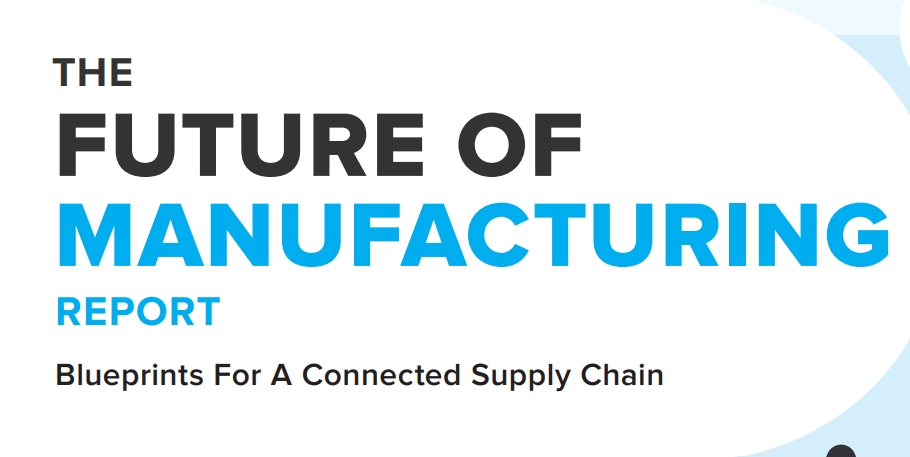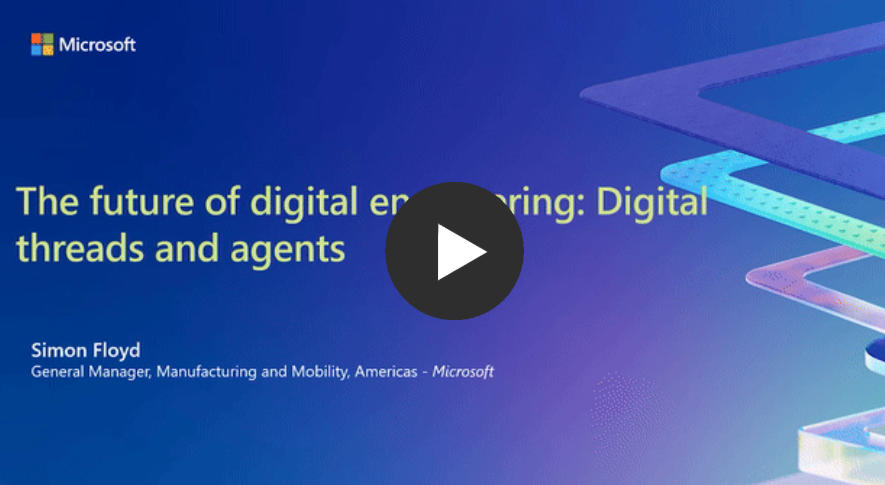Review some SAP ERP solutions, functionalities, and capabilities that you can use to meet the challenges of specific International Financial Reporting Standards (IFRS) and International Accounting Standards (IAS) requirements, including ones that cover revenue, accounting policies, operating segments, and more.
Key Concept
International Accounting Standards (IAS) and International Financial Reporting Standards (IFRS) guide global financial accounting practices and reporting. The aim of these standards is to harmonize financial accounting and reporting standards of different countries. SAP solutions for global accounting and financial reporting standards are a set of functionalities and components that are designed to enforce compliance with and adherence to IFRS. To ensure total compliance and optimize the many benefits, it is expedient to appropriately configure these solutions based on international financial reporting best practices, requirements, and standards.
Compliance with International Financial Reporting Standards (IFRS) and International Accounting Standards (IAS) is a pressing issue for most companies as the deadline for adoption draws closer. Over the years, the International Accounting Standards Board (IASB) has amended a number of IAS standards and replaced some with IFRS standards. Furthermore, the regulatory body has adopted some IFRS standards on matters that are not covered by IAS standards.
ERP systems play an important role in simplifying and streamlining the adoption of global accounting and financial reporting standards. Even if you are already using SAP ERP for managing business processes and reporting, you likely will need to reevaluate the capability and adequacy of your system to satisfy global reporting requirements. IFRS-compliant solutions must be able to do the following:
- Support subledger accounting, hedge accounting, parallel accounting, parallel valuation, and multi-currency
- Leverage a centralized database management system to enhance flexibility of financial reporting, analytics, planning, and consolidation
- Integrate business processes across the enterprise
- Support efficient data exchange through Extensible Business Reporting Language (XBRL)
- Be scalable and adaptable to cater to dynamic reporting standards as a result of changes to international reporting standards, disclosure requirements, and standards reviews
These attributes are targeted at ensuring and enforcing compliance with global reporting standards in the areas of project management (construction contracts), revenue recognition, segment reporting, fixed asset management, leasing, governance, risk, and compliance (GRC), and so on. SAP ERP Financials, coupled with systems such as SAP ERP Human Capital Management or SAP BusinessObjects GRC solutions, plays a key role in achieving IFRS compliance. To optimize the benefits of the system for IFRS compliance, the system has to be well-configured to ensure that transactions are automatically and correctly posted to the right General Ledger accounts.
I’ll discuss how you can address various global accounting standards in your SAP ERP system. I’ll discuss the following standards:
- IAS 11, IAS 18, and IAS 20, which relate to revenue recognition
- IAS 16, IAS 36, and IAS 38, which relate to asset management
- IAS 17, which addresses leasing
- IAS 8, which addresses changes in accounting policies and estimates
- IFRS 8, which addresses segment reporting
Revenue Recognition: IAS 11, IAS 18, and IAS 20
The following sections of IAS regulate revenue recognition: Construction Contracts (IAS 11), Revenue (IAS 18), and Accounting for Government Grants and Disclosure of Government Assistance (IAS 20).
IAS 11
The objective of IAS 11 is to provide guidelines for the accounting management of revenue and costs related to construction contracts in the financial statement of the contractor. A construction contract is defined as a contract that is specifically negotiated for the construction of an asset and includes services rendered that are directly related to the construction.
IAS 11 stipulates that where possible, the revenue and expense of construction contracts and services should be recognized using the percentage of completion (PoC) method. The stage of completion of a contract should form the basis for reliably measuring revenue and costs. When it is impossible to ascertain the PoC of a contract, no profit is recognized. However, contract revenue is recognized only to the extent that contract costs incurred are expected to be recovered and they are expensed as incurred.
Furthermore, loss should be recognized immediately if it is probable that total contract costs will exceed total contract revenue. The disclosure requirements of IAS 11 include the amount of contract revenue recognized, the method of determining that revenue, the method of determining the percentage of completion, aggregate cost incurred, and recognized profit for contracts in progress at the balance sheet date.
In SAP ERP Financials, you can perform result analysis automatically for cost objects by leveraging different methods of determining PoC. You can use the PoC functionality in SAP Project System to comply with IFRS regulations by objectively measuring the extent of work done on long-term construction contracts and services while taking into consideration the planned and actual job done. The PoC methods include:
- Cost proportional PoC method
- Revenue proportional method
- Quantity proportional PoC method
- PoC method based on planned revenue for each period
- PoC method based on project progress value determination
The project progress value that the system generates is largely dependent on the defined measurement technique used for PoC calculation. The requirement to leverage PoC for any agreement that extends beyond the term of reporting for both construction and service contracts as addressed in IAS 11 is designed to exercise control on project management reporting. You can also use PoC functionality in Managerial Accounting (CO) to create appropriate postings at period-end closing.
The PoC forms the basis for calculating the revenue and cost of sale for a particular period. When the revenue proportional method is used, the PoC is determined using the relationship between actual and planned revenue. When you use the cost proportional PoC method, the PoC is determined using the relationship between actual cost and planned cost.
The PoC method based on project progress value determination in Project System supports different measurement techniques shown in Figure 1, which you can reach by following menu path SAP Customizing Implementation Guide > Project System > Progress > Progress Analysis > Define Measurement Methods.
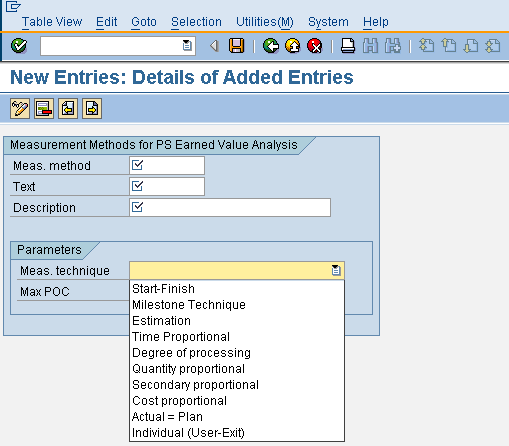
Figure 1
Measurement techniques for PoC method based on project progress value determination
IAS 18
The objective of IAS 18 is to define accounting treatment for revenue arising from specific types of transactions and events (e.g., sales of goods and services, interests, royalties, and dividends). IAS 18 stipulates that revenue should be measured at fair value of the consideration received or receivable. The criteria for recognizing different revenue sources are highlighted below:
- Revenue arising from sales of goods is recognized when significant risks and rewards of ownership have been completely transferred to the buyer and the seller has lost control. Then you can reliably measure the costs and revenue.
- Revenue from rendering services is recognized when the outcome of the transaction can be reliably estimated using PoC
- Revenue from interest is recognized when there is assurance that economic benefit will get to the entity based on an effective interest method
- Revenue from royalties is recognized when there is assurance that economic benefit will get to the entity based on the substance of the agreement
- Revenue from dividends is recognized when there is assurance that economic benefit will get to the entity based on the evidence of the shareholders’ right to receive payment
In SAP ERP Financials, revenue is automatically recognized against appropriate SAP General Ledger accounts as defined in configuration and the chart of accounts when a customer is invoiced for goods bought or services rendered. You can further analyze the captured revenue by drilling down to see the originating transactions. Depending on the business environment, you may also create manual journals with appropriate descriptions against appropriate General Ledger accounts. This applies to other forms of revenue such as interest, royalties, and dividends.
IAS 20
The objective of IAS 20 is to define the accounting management and disclosure requirements of grants and assistance from government. The standard stipulates that government grants should be acknowledged only when there is reasonable assurance that the grant will be received and the entity will comply with the terms and conditions of the grant. Government grants should be accounted for in profit or loss over the periods and linked to the related costs for which they are actually meant. Asset-related grants are either offset against the carrying amount of the relevant asset or presented as deferred income in the statement of financial position. Repayment of a government grant is treated as a change in accounting estimate with different treatments for income and asset-based grants.
SAP ERP Financials has functionalities aimed at performing automated posting of government grants to appropriate General Ledger accounts as configured. You can use Asset Accounting (FI-AA) to effectively manage and report asset-based grants from the government. Project System allows you to manage and account for projects embarked upon using government grants and assistance.
Asset Management: IAS 16, IAS 36, and IAS 38
The following IAS sections deal with asset management: Asset Management: Property, Plant and Equipment (IAS 16), Impairment of Assets (IAS 36), and Intangible Assets (IAS 38).
IAS 16
The objective of IAS 16 is to determine how property, plants, and equipment are initially recognized and treated in an accounting environment. They are recognized as an asset when the cost of the asset can be reliably measured and the entity will obtain future economic benefit from the asset. The initial recognition is at cost. After acquisition, assets are carried at historical cost minus impairment and accumulated depreciation (known as the cost model) or at a revalued amount minus impairment and accumulated depreciation (known as the recovery model). The depreciable amount of property, plants, and equipment is depreciated systematically over the asset’s useful life. When they consist of components with different useful lives, depreciation is charged based on each component’s useful life. When a component is replaced, the newly replaced component is capitalized to the extent that it meets the recognition criteria of an asset. The carrying amount of the components replaced is not recognized.
An intangible asset is a non-monetary asset that can be easily identified and is without physical substance, such as software and trademarks. An intangible asset can be self-created or purchased. Intangible assets that are separately acquired are initially recognized at cost. The cost attributable to many internally generated intangible assets such as research and advertising cannot be capitalized and are expensed as incurred. Intangible assets are systematically amortized based on their useful life unless they possess an indefinite useful life. Intangible assets with finite useful lives are tested for impairment when there is an indication of impairment. Intangible assets with infinite useful lives and intangible assets that have never been used are tested for impairment at least annually and more often if there is evidence of impairment.
IAS 36
The aim of the standard on impairment of asset (IAS 36) is to define how the recoverable amount of an asset is calculated and ensure that assets are carried at no more than their recoverable amount. The recoverable amount is the higher of the asset’s fair value minus costs to sell and its value in use. At the end of each reporting period or annually (for goodwill and other intangible assets with indefinite useful lives), assets are examined for impairment. If an asset has been impaired, the recoverable amount of the asset is calculated. When you cannot calculate a recoverable amount for a specific asset, the recoverable amount of the asset’s cash generating unit (CGU) is determined.
You can use FI-AA to effectively manage these kinds of assets to ensure compliance with IFRS requirements. It allows you to classify assets as intangible assets, lease assets, finance assets, and assets under consideration, among others. FI-AA supports different depreciation types including ordinary, special, and unplanned. Ordinary depreciation is used for planned depreciation of an asset over a defined period of time (useful life). Special deprecation is driven by tax requirements and implies the depreciation of an asset on a percentage basis independent of planned depreciation. Unplanned depreciation is carried out in the event of an unfavorable incident that affects the value of an asset.
Support is also provided for the depreciation of an asset to a scrap value (not necessarily a net book value of 0). The system allows you to separately depreciate the components of an asset based on the defined useful lives of the different components. Furthermore, FI-AA supports different depreciation methods including straight-line depreciation over total useful life, straight line from the book value over remaining useful life, declining balance method of depreciation, declining multi-phase depreciation, sum of the years-digits method of depreciation, and mean value method.
The treasury and investment management components of SAP ERP Financials allow an entity to capitalize the cost of internally generated intangible assets as required under IAS 38. The SAP system helps organizations separately disclose (independent of goodwill) and quantify the value of their intangible assets such as software, trademarks, and patents by using FI-AA. You can manage the capitalization of intangible assets via appropriate fixed asset characteristics assignment such as depreciation period, useful life, and depreciation method. Assets can also be revalued in SAP ERP after impairment has been established.
Leasing: IAS 17
IAS 17 covers leasing, including financing and operating leases. For a finance lease, the lessee substantially possesses all the risks and rewards consequential to ownership while all other forms of leases are considered as operating leases. This standard distinguishes a lease of land from a lease of building. For a finance lease, the lessee recognizes it as an asset, pays rent, and depreciates the asset, while the lessor recognizes the leased asset as a receivable. For an operating lease, the lessee does not recognize it as an asset so the lessor is responsible for depreciating the asset. The rental paid is recognized as an expense in the income statement of the lessee and credited to that of the lessor on a straight-line basis. Depreciation is charged systematically using the useful life of the leased asset.
You can use FI-AA to manage lease transactions in the SAP ERP system. Furthermore, SAP Leasing, designed for managing lease accounting transactions, is invaluable for meeting the reporting specifics of IFRS. Figure 2, which you access via transaction FILAEXPL in FI, shows a sample lease element containing some basic lease information such as contract number, lease start date, and lease end date.
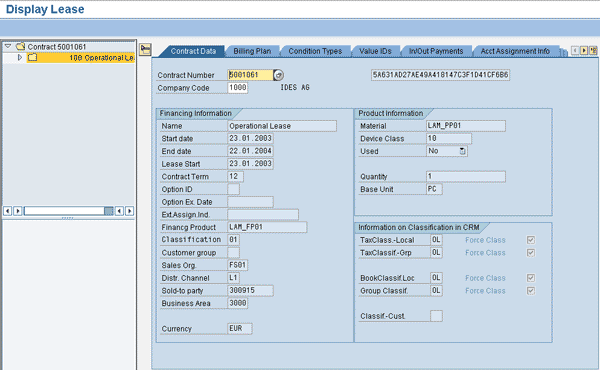
Figure 2
An operating lease contract data sheet
Lease accounting in the SAP system allows you to define accounting principles (Figure 3) such as IAS and US Generally Accepted Accounting Principles (GAAP) for the purpose of representing parallel method in an additional ledger. You access Figure 3 by following menu path SAP Customizing Implementation Guide > Financial Accounting > Lease Accounting > Basic Settings > Define Accounting Principles. Defined accounting principles are available in different functions of FI such as foreign currency valuation and provisions for awards.
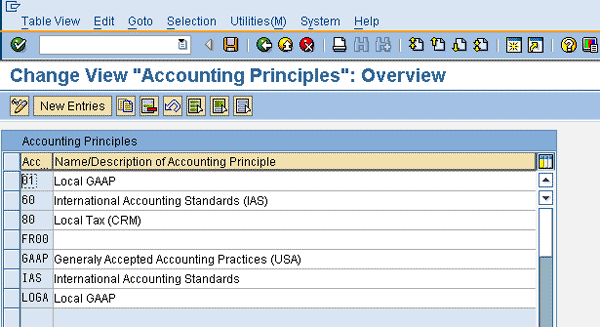
Figure 3
Accounting principles
FI-AA supports a number of methods for the management of the values of leased assets. The lease type functionality is the indicator that defines how a leased asset is managed, either as a finance lease or an operating lease.
In FI-AA, the acquisition value of a finance lease is calculated using the present value of the future lease payments as defined in the leasing agreement. You can depreciate leased assets based on the useful life of the lease asset using FI-AA.
You can use the asset class account allocation to determine the account to be posted for leased assets. Furthermore, you can retire leased assets in the event of lease expiration, cancellation, and scrapping. Also, FI-AA effectively manages lease payment to ease compliance with IFRS requirements. For finance lease payments, the liabilities are booked against the opening posting while the asset control account serves as the offsetting account. For an operating lease payment, the system allows the use of appropriate recurrent postings that ensure the posting of lease payments as a rental expense in the profit and loss statement.
Changes in Accounting Policies and Estimates: IAS 8
The objective of IAS 8 is to define how you account for, treat, and present changes in accounting policies, changes in accounting estimates, and errors in the income statement. You should apply accounting policies consistently to similar transactions. Changes in accounting estimates are accounted for retroactively by recognizing the effects in the profit or loss against the affected period (period of the change and future period).
Prior-period errors are accounted for retroactively by restating the comparative amount unless this is not practicable. In that case, you need to restate the opening balances of assets, liabilities, and entities for the earliest period for which retroactive restatement is practicable.
Audit Information System (AIS), which is standard, provides a platform for monitoring inherent security controls by reviewing appropriate standard reports for business, system, and tax audit. Schedule Manager is an integrated tool for defining, scheduling, and monitoring periodic processes such as period-end closing. You can access Schedule Manager by following menu path Accounting > Financial Accounting > General Ledger > Periodic Processing > Schedule Manager in SAP ERP Financials.
Schedule Manager has a work list-based error analysis and integrated error-handling procedures that help ensure timely posting error analysis and corrections. SAP Strategic Enterprise Management (SAP SEM) also plays a vital role in enforcing control in an accounting environment via its support for document-level drill down, automatic posting, customer definable validation rules, risk management, complete audit trail, and exception reporting.
To minimize error posting and fraud possibilities, SAP ERP leverages system controls that include:
- Standard controls: Come standard with the SAP system
- Configured controls: Defined at the time of system configuration
- Security controls: Enforced via user authorization and segregation of duties (SoD)
- Reporting controls: Based on standard or ad hoc SAP reports
Segment Reporting: IFRS 8
The objective of this standard, which replaces IAS 14, is to define the principle for the reporting of financial information based on the line of business and geographical locations of an entity. The principle requires an entity to disclose information to enable users of its financial statements to evaluate the nature and financial effects of the business in which it engages and the economic environments in which it operates. It requires all entities with quoted equity or debt instruments to disclose information about its operating segments. This requirement also applies to entities that are in the process of obtaining a listing, quotation of debt, or equity instruments in a public market. A reportable segment is an operating segment that satisfies the following conditions:
- The revenue from sales to external customers and from transactions with other segments is at least 10% of total sales
- The profit and loss is at least 10% of the total profit and loss
- The assets are at least 10% of the total assets of all segments
- Seventy-five percent of an entity’s revenue must be included in the reportable segment. Furthermore, it stipulates that even though an entity has only one reporting segment, information about each product and service or group of products and services must be disclosed.
Generating reports that comply with international standard segment reporting can be challenging considering the various disclosures that have to be made. SAP ERP Financials has tools for achieving segment reporting as it relates to IFRS by leveraging components such as profit center accounting, business area accounting, and SAP General Ledger. Furthermore, SAP ERP supports different financial and management accounting segment reporting objects which include profit center, business area, and internal order, among others.
These objects help you generate accurate and reconcilable financial statements across the enterprise as illustrated in Figure 4, which shows the possible selection criteria for generating a new financial statement via transaction S_PLO_86000028. You can derive segments from the profit center with the SAP General Ledger. Profit Center Accounting (EC-PCA) is tightly integrated with the SAP General Ledger, thus allowing the generation of profit center reporting objects based on financial statements from the SAP General Ledger. SAP ERP Financials supports the definition of segments for similar business transactions and multi-segment reporting.
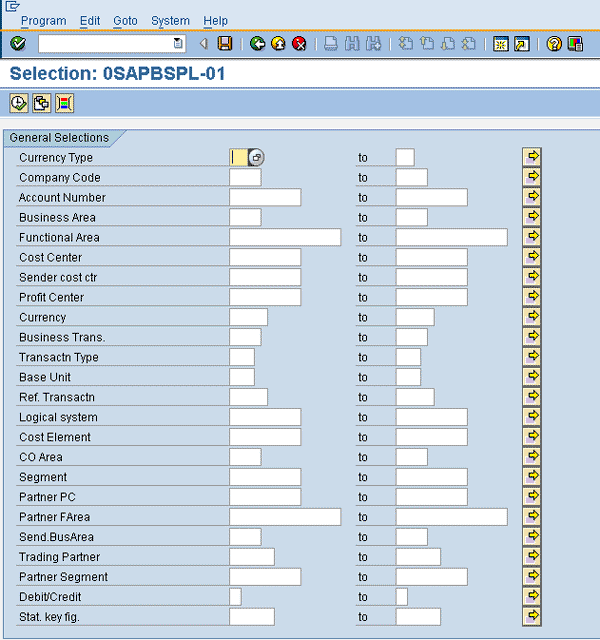
Figure 4
New financial statement selection criteria
Document splitting functionality in SAP ERP is used to add flexibility to segment reporting. It allows document line items to be divided for defined dimensions to generate financial statements, thus eliminating the need to update segments by periodic adjustment postings. SAP ERP Financials allows you to generate segmented financial statements based on defined dimensions by defining them as splitting characteristics by following the path: Financial Accounting (New) > General Ledger Accounting (New) > Business Transactions > Document Splitting > Define Document Splitting Characteristics for General Ledger Accounting (Figure 5).
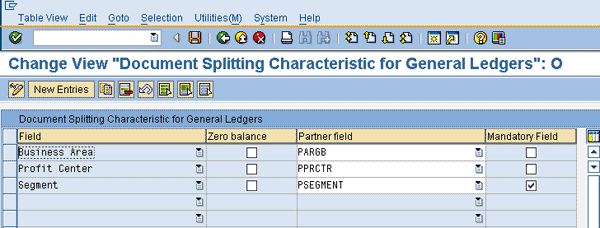
Figure 5
Document splitting characteristics for general ledgers
Furthermore, you can integrate with SAP BusinessObjects Business Planning and Consolidation, SAP NetWeaver Business Warehouse (SAP NetWeaver BW), and SAP SEM to achieve accurate segment reporting and financial account consolidation.
Kehinde Eseyin
Kehinde Eseyin is a security architect. He holds a bachelor’s degree in computer science. He has about 12 years of IT security, governance framework, IS risk, and compliance experience gained by working in numerous global organizations. Over the years, he has demonstrated competencies in security design, information assurance, cyber security, data privacy, threat and vulnerability management, penetration testing, business architecture, project management, IT audit, IS controls framework, and identity and access management.
You may contact the author at eseyinok@gmail.com.
If you have comments about this article or publication, or would like to submit an article idea, please contact the editor.








